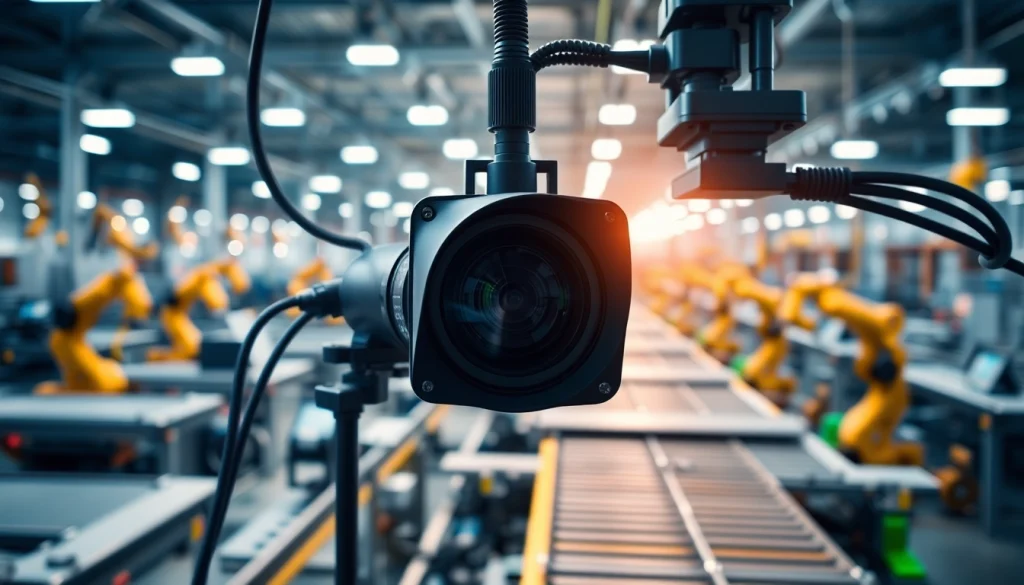Understanding Machine Vision: Applications, Benefits, and Systems

What is Machine Vision?
Definition and Functionality
Machine vision refers to the technology that enables machines to see and interpret visual information in a manner similar to human sight. It combines various elements such as cameras, digital image processing, and artificial intelligence (AI) to replicate or augment the visual capabilities of humans. By utilizing machine vision, systems can perform tasks like identifying defects, measuring dimensions, and guiding robotic operations in an industrial setting.
Historical Evolution of Machine Vision Technology
The evolution of machine vision has been nothing short of remarkable. The technology originated in the 1960s with rudimentary systems equipped with cameras and simple algorithms to analyze images for specific patterns. However, as computational power and programming techniques advanced, so did the capabilities of machine vision systems. The integration of neural networks in the 1990s marked a significant leap, enabling more complex visual recognition tasks. Today, machine vision is employed across several sectors, including automotive, electronics, pharmaceuticals, and even agriculture.
Components of Machine Vision Systems
A machine vision system typically consists of three main components:
- Imaging Devices: The foundation of any machine vision system is its cameras and sensors, which capture images of the target objects or environments.
- Processing Unit: This can be a software application or a dedicated hardware device that analyzes the captured images using algorithms designed for specific tasks. Common functions include filtering, processing, and object recognition.
- Output Interface: After processing the images, the results are communicated via various output methods, including displays, alarms, or direct instructions to other machinery.
Applications of Machine Vision
Quality Control in Manufacturing
Machine vision has revolutionized quality control processes in manufacturing. Traditional methods often involve manual inspection, which can be prone to human error and inconsistency. Machine vision systems, equipped with advanced image processing capabilities, can detect defects or irregularities in products at high speed and precision. For example, in the automotive industry, machine vision is employed to inspect components such as welds and paint finishes, ensuring they meet stringent quality standards.
Medical Imaging and Analysis
In healthcare, machine vision plays a vital role in medical imaging and diagnostics. Technologies such as MRI and CT scans rely heavily on advanced imaging techniques. Machine vision systems aid radiologists by enhancing image clarity, improving diagnostic accuracy, and automating the identification of abnormalities in scans. Automated systems can process large volumes of images quickly, allowing healthcare professionals to focus on patient care rather than data processing.
Machine Vision in Robotics
Robots equipped with machine vision capabilities are pivotal in automation across various sectors. In warehouses, for instance, robotic arms use machine vision to recognize items, assess their locations, and handle them accurately. This technology significantly improves the efficiency and speed of operations, meeting the growing demands for fast, reliable service in logistics. Moreover, machine vision enables robots to adapt to varying environments, making them more versatile in applications such as autonomous driving and surveillance.
Benefits of Implementing Machine Vision
Increased Efficiency and Accuracy
The primary advantage of machine vision systems is their ability to enhance efficiency and accuracy in various processes. By automating inspection and analysis, companies can reduce the time and costs associated with manual methods. For example, a study demonstrated that integrating machine vision in manufacturing lines can improve processing speeds by 50% while maintaining a lower defect rate compared to manual inspections.
Cost-Effectiveness in Production
Implementing machine vision technology can lead to substantial cost savings over time. While the initial investment may be significant, the long-term benefits far outweigh the costs. Automated systems reduce labor costs, minimize waste from defective products, and lead to improved overall productivity. Companies can expect a quick return on investment, particularly in sectors where precision is critical, such as electronics or pharmaceuticals.
Enhanced Data Collection and Analysis
Machine vision systems facilitate the collection of large datasets, which can be invaluable for analysis and decision-making. The data gathered through machine vision can be used to identify trends, optimize processes, and forecast future needs. By leveraging big data analytics, businesses can create predictive models that enhance operational efficiency and product quality.
Types of Machine Vision Systems
2D vs. 3D Machine Vision Systems
Machine vision systems can be broadly categorized into 2D and 3D systems, each serving different purposes. 2D machine vision is predominantly used for surface inspection, barcode reading, and dimensional measurements. It relies on standard cameras to capture flat images. In contrast, 3D machine vision systems utilize multiple cameras or laser sensors to gather depth information, making them suitable for applications requiring a detailed understanding of object shapes, such as in robotics and automated assembly.
Smart Cameras: Advantages and Usage
Smart cameras integrate the functions of imaging, processing, and communication into a single device, offering several advantages over traditional machine vision systems. These cameras are capable of performing real-time analysis directly at the source, reducing latency and increasing efficiency. Smart cameras are often employed in production lines for tasks like quality assurance and sorting due to their ability to adapt to various conditions and tasks seamlessly.
Integration with Other Technologies
The integration of machine vision with other technologies such as artificial intelligence, the Internet of Things (IoT), and robotics is paving the way for more sophisticated solutions. For instance, AI-driven machine vision systems can learn and adapt their algorithms over time, becoming more accurate as they process more data. This synergy enables more robust applications in manufacturing, traffic management, and remote inspections, enhancing overall system capabilities.
Future Trends in Machine Vision
AI and Machine Learning Integration
As machine vision technology evolves, the integration of AI and machine learning is becoming increasingly prevalent. AI algorithms enable systems to analyze visual data more effectively, allowing for real-time decision-making based on patterns that may not be immediately apparent to human operators. This trend is particularly significant in industries where adaptability and learning from data are crucial, such as autonomous vehicles and advanced robotics.
Advancements in Imaging Technology
Future advancements in imaging technology promise to enhance the capabilities of machine vision systems. Technologies such as hyperspectral imaging and high-resolution cameras will enable systems to capture and analyze more detailed visual data than ever before. These improvements will expand the range of applications for machine vision, making it indispensable in fields like agriculture, food quality control, and environmental monitoring.
Market Predictions and Emerging Applications
Industry analysts predict significant growth in the machine vision market over the next decade, driven by advancements in technology and the increasing demand for automation across various sectors. Emerging applications, particularly in fields such as healthcare for diagnostics and monitoring, agriculture for crop and soil analysis, and security for surveillance, will play a major role in this growth. Businesses that adapt and implement machine vision solutions are expected to gain a competitive edge by enhancing efficiency, reducing operational costs, and improving quality standards.







